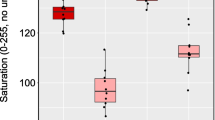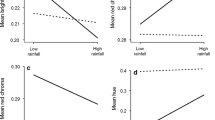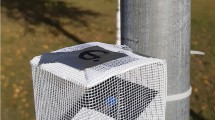Abstract
The signaling function of carotenoid-based plumage is mainly determined by the concentration of pigments in feathers. For this reason, most studies of the proximate control of coloration focus on processes during and preceding moult. In great tits Parus major, past research demonstrates that carotenoid-based plumage coloration honestly indicates male quality and, thus, may be a sexually selected signal. In this study, we investigate how dirt and preen oil influence the coloration of carotenoid-based feathers in the great tit. We collected six feathers from each individual bird; three feathers served as controls while the remaining three feathers were washed with a chloroform/methanol mixture to remove soil and preen waxes. We assessed plumage coloration using digital photography. This cleaning procedure slightly enhanced ornamentation; the experimentally cleaned feathers expressed hues shifted towards shorter wavelengths and expressed brighter overall coloration than control feathers. This is the first experimental study conducted on wild birds demonstrating that, in addition to pigment concentration, the presence of preen waxes and soils on feathers may contribute to variation in coloration.


Similar content being viewed by others
References
Blanco G, Seoane J, de la Puente J (1999) Showiness, non-parasitic symbionts, and nutritional condition in a passerine bird. Ann Zool Fenn 36:83–91
Contgreave P, Clayton DH (1994) Comparative analysis of time spent grooming by birds in relation to parasite load. Behaviour 131:171–187
Cuthill IC, Partridge JC, Bennett ATD, Church SC, Hart NS, Hunt S (2000) Ultraviolet vision in birds. Adv Study Behav 29:159–214
Delhey K, Peters A, Johnsen A, Kempenaers B (2006) Seasonal changes in blue tit color: do they signal individual quality? Behav Ecol 17:790–798
Faivre B, Grégorie A, Préault M, Cézilly F, Sorci G (2003) Immune activation rapidly mirrored in secondary sexual trait. Science 300:103
Figuerola J, Senar JC (2005) Seasonal changes in carotenoid- and melanin-based plumage coloration in great tit Parus major. Ibis 147:797–802
Fitze PS, Richner H (2002) Differential effects of a parasite on ornamental structures based on melanins and carotenoids. Behav Ecol 13:401–407
Galván I, Sanz JJ (2006) Feather mites abundance increases with uropygial gland size and plumage yellowness in great tits Parus major. Ibis 148:687–697
Grande JM, Negro JJ, Torres MJ (2004) The evolution of bird plumage colouration: a role for feather-degrading barcteria? Ardeola 51:375–383
Griffith SC, Pryke SR (2006) Benefits to females of assessing color displays. In: Hill EG, McGraw KJ (eds) Bird coloration. Function and evolution, vol. 2. Harvard University Press, Cambridge, Massachusetts, pp 233–279
Hill EG (2002) A red bird in a brown bag. The function and evolution of colorful plumage in the House Finch. Oxford University Press, Oxford
Hill EG (2006) Female mate choice for ornamental coloration. In: Hill EG, McGraw KJ (eds) Bird coloration. Function and evolution, vol. 2. Harvard University Press, Cambridge, Massachusetts, pp 137–200
Hörak P, Ots I, Vellau H, Spottiswoode C, Møller AP (2001) Carotenoid-based plumage coloration reflects hemoparasite infection and local survival in breeding great tits. Oecologia 126:166–173
Lessells CM, Boag PT (1987) Unrepeatable repeatabilites: a common mistake. Auk 104:116–121
McGraw KJ, Hill GE (2004) Plumage color as a dynamic trait: carotenoid pigmentation of male house finches Carpodacus mexicanus fades during the breeding season. Can J Zool 82:734–738
McGraw KJ, Hudon J, Hill GE, Parker RS (2005) A simple and inexpensive chemical test for behavioral ecologists to determine the presence of carotenoid pigments in animal tissues. Behav Ecol Sociobiol 57:391–397
McNett GD, Marchetti K (2006) Ultraviolet degradation in carotenoid patches: live versus museum specimens of wood warblers (Parulidae). Auk 122:793–802
Montgomerie R (2006) Cosmetic and adventitious colors. In: Hill EG, McGraw KJ (eds) Bird coloration. Mechanism and measurements, vol. 1. Harvard University Press, Cambridge, Massachusetts, pp 399–427
Montgomerie R, Lyon B, Holder K (2001) Dirty ptarmigan: behavioral modification of conspicuous male plumage. Behav Ecol 12:429–438
Moreno-Rueda G (2005) Is the white wing-stripe of male House Sparrows Passer domesticus an indicator of the load of Mallophaga? Ardea 93:109–114
Negro JJ, Margalida A, Hiraldo F, Heredia R (1999) The function of the cosmetic coloration of bearded vultures: when art imitates life. Anim Behav 58:F14–F17
Nowakowski JK (2001) Speed and synchronisation of autumn migration of the great tit Parus major along the eastern and the southern Baltic coast. Ring 23:55–71
Partali V, Liaaen-Jensen S, Slagsvold T, Lifjeld JT (1987) Carotenoids in food chain studies. II. The food chain of Parus spp. Monitored by carotenoid analysis. Comp Biochem Physiol B 87:885–888
Piersma T, Dekker M, Sinninghe Damsté JS (1999) An avian equivalent of make-up? Ecol Lett 2:201–203
Poltz J, Jacob J (1974) Waxes of uropygial gland secretion of birds of the genus Parus. BBA 360:348–356
Reneerkens J, Korsten P (2004) Plumage reflectance is not affected by preen wax composition in red knots Calidris canutus. J Avian Biol 35:405–409
Sandilands V, Savory J, Powell K (2004) Preen gland function in layer: factors affecting morphology and feather lipid levels. Comp Biochem Physiol A 137:217–225
Senar JC (2006) Color displays as intrasexual signals of aggression and dominance. In: Hill EG, McGraw KJ (eds) Bird coloration. Function and evolution, vol. 2. Harvard University Press, Cambridge, Massachusetts, pp 87–136
Senar JC, Quesada J (2006) Absolute and relative signals: a comparison between melanin- and carotenoid-based patches. Behaviour 143:589–595
Senar JC, Figuerola J, Domènech J (2003) Plumage coloration and nutritional condition in the great tit Parus major: the roles of carotenoids and melanis differ. Naturwissenschaften 90:234–237
Tschirren B, Fitze P, Richner H (2005) Carotenoid-based nestling coloration and parental favouritism in the great tit Parus major. Oecologia 143:477–482
Willoughby EJ, Murphy M, Gorton HL (2002) Moult, plumage abrasion, and color change in Lawrence’s goldfinch. Wilson Bull 114:380–392
Yorinks N, Atkinson CT (2000) Effects of malaria on activity budgets of experimentally infected juvenile apapane Himatione sanguine. Auk 117:731–738
Zampiga E, Hoi H, Pilasto A (2004) Preening, plumage reflectance and female choice in budgerigars. Ethol Ecol Evol 16:339–349
Örnborg J, Andersson S, Griffith SC, Sheldon BC (2002) Seasonal changes in a ultraviolet colour signal in blue tits, Parus caeruleus. Biol J Linn Soc 76:237–245
Acknowledgment
Our survey would not have been possible without the help of many people. Volunteers working at ringing posts gathered biometric data. Monika Miller assessed preen wax and dirt load present on feathers. Ewa Waliszewska and Wojciech Kubasik supplied us with photographic equipment. Patrick Fitze and Alex Badyaev generously shared their knowledge about using photography in color measurements. Piotr Tryjanowski critically read early drafts of the manuscript. The manuscript was greatly improved by comments of Juan Carlos Senar and two anonymous referees. Special thanks are due to Lynn Siefferman for her valuable advices at various stages of this study and as well as help with language revision. All experiments done in the course of the study comply with the current laws of Poland.
Author information
Authors and Affiliations
Corresponding author
Rights and permissions
About this article
Cite this article
Surmacki, A., Nowakowski, J.K. Soil and preen waxes influence the expression of carotenoid-based plumage coloration. Naturwissenschaften 94, 829–835 (2007). https://doi.org/10.1007/s00114-007-0263-x
Received:
Revised:
Accepted:
Published:
Issue Date:
DOI: https://doi.org/10.1007/s00114-007-0263-x




